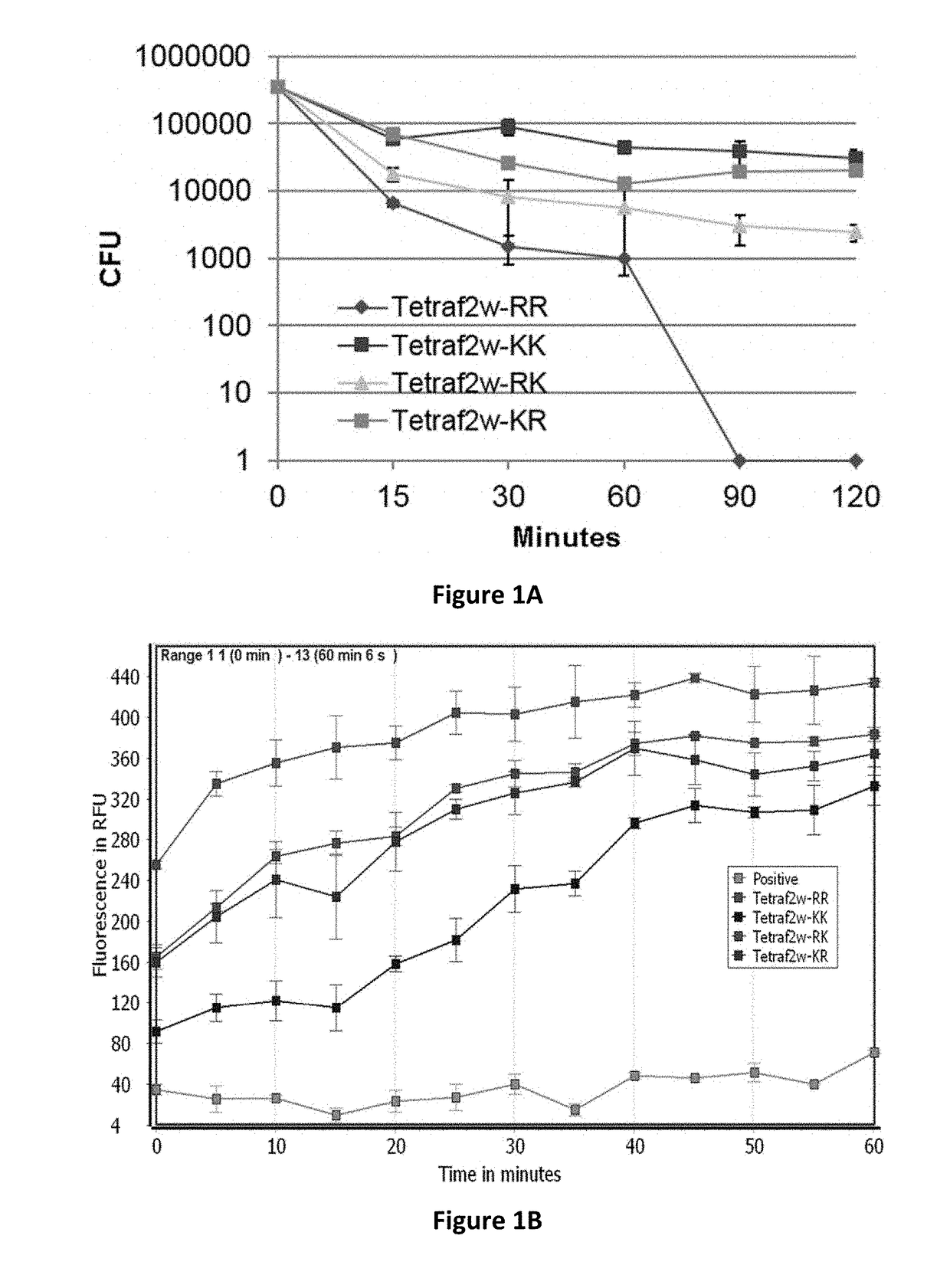Anti-microbial peptides and coatings
a technology of anti-microbial peptides and coatings, which is applied in the field of anti-microbial peptides and the treatment of microbial infections, can solve problems such as adding an unwanted burden to medical car
- Summary
- Abstract
- Description
- Claims
- Application Information
AI Technical Summary
Problems solved by technology
Method used
Image
Examples
example 1
[0082]Natural antimicrobial peptides (AMPs) are host defense molecules identified in various organisms ranging from bacteria to humans. The majority of these molecules contain 10-50 amino acids with net charges 0-+7 and hydrophobic contents 31-70% (Wang, G. (2013) Pharmaceuticals 6:728-758; Wang et al. (2016) Nucleic Acids Res., 44:D1087-1093). AMPs can rapidly kill invading pathogens by disrupting membranes, rendering it difficult for pathogens to develop resistance. Moreover, multiple types of AMPs could be expressed in humans to control pathogens by different mechanisms (Wang, G. (2014) Pharmaceuticals 7:545-594). In addition, these molecules can also regulate immune responses. All these properties made them appealing candidates for developing new therapies.
[0083]There is a high interest in linear AMPs because such peptides can be readily synthesized. It has been found that a 10-residue non-toxic bacterial membrane anchor can be converted to a 13-residue antibacterial peptide by ...
example 2
[0144]Biofilm-related infections on implanted medical devices are a challenging issue (Darouiche, R. O. (2004) New Eng. J. Med., 350:1422-1429). Such infections can cause implant failures, increase treatment costs, and lead to high morbidity and mortality (Zhao et al. (2009) J. Biomed. Mater. Res. B Appl. Biomater., 91B:470-480; Xavier et al. (2016) Mater. Sci. Eng. C Mater. Biol. Appl., 68:837-841). Therefore, the best strategy is to prevent such infections (Costa et al. (2011) Acta Biomater., 7:1431-1440; Onaizi et al. (2011) Biotechnol. Adv., 29:67-74). One promising method is to coat antimicrobials on the biomaterial surface. In the past years, both metals (e.g., silver, zinc, copper, and zirconium) and non-metals (e.g., selenium and antibiotics) have been used for coating (Gallo et al. (2014) Int. J. Mol. Sci., 15:13849-13880). The effective use of metals such as silver is complicated by leaching and cytotoxicity issues. However, a prolonged use of antibiotics results in reduce...
example 3
[0178]Naturally occurring antimicrobial peptides (AMPs) are endogenous defense molecules of living organisms (Zasloff, M. (2002) Nature 415:389-395; Hancock et al. (2006) Nat. Biotechnol., 24:1551-1557; Epand et al. (1999) Biochim. Biophys. Acta 1462:11-28). They remain potent for millions of years, making them appealing templates for developing the next generation of antimicrobials to combat superbugs and difficult-to-kill viruses. The amino acid use in such peptides is biased so that they have the desired sequence feature to recognize invading pathogens. In α-helical amphibian AMPs, glycine, leucine, alanine, and lysine are rich, whereas glycine, arginine, and cysteine are abundant in (3-sheet peptides. Such abundant amino acids can determine the peptide scaffold (Wang et al. (2016) Nucleic Acids Res., 42:D1087-D1093; Wang, G. (2010) Antimicrobial Peptides: Discovery, Design and Novel Therapeutic Strategies, Cambridge, CABI). In contrast, certain amino acids, such as histidine (Hi...
PUM
| Property | Measurement | Unit |
|---|---|---|
| emission wavelengths | aaaaa | aaaaa |
| emission wavelengths | aaaaa | aaaaa |
| pH | aaaaa | aaaaa |
Abstract
Description
Claims
Application Information
 Login to View More
Login to View More - R&D
- Intellectual Property
- Life Sciences
- Materials
- Tech Scout
- Unparalleled Data Quality
- Higher Quality Content
- 60% Fewer Hallucinations
Browse by: Latest US Patents, China's latest patents, Technical Efficacy Thesaurus, Application Domain, Technology Topic, Popular Technical Reports.
© 2025 PatSnap. All rights reserved.Legal|Privacy policy|Modern Slavery Act Transparency Statement|Sitemap|About US| Contact US: help@patsnap.com



